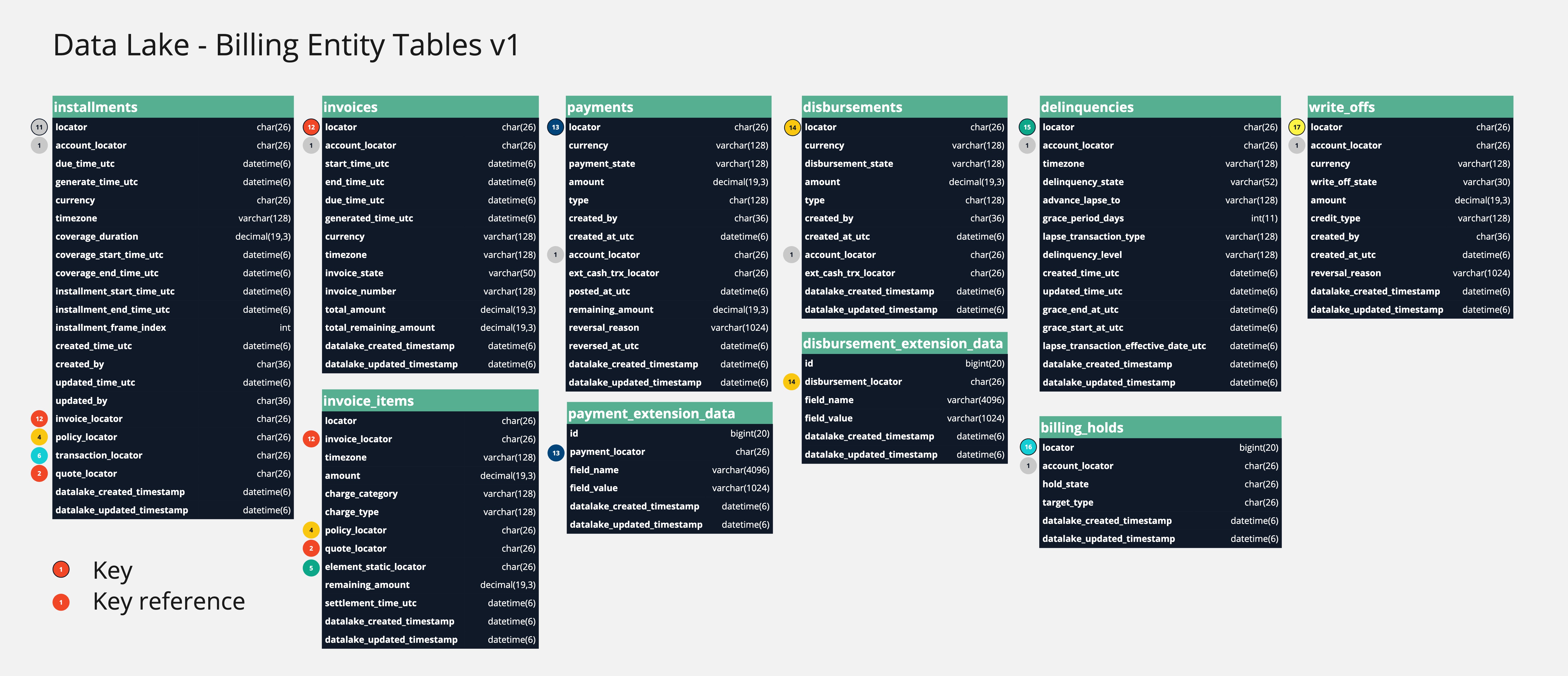Data Lake
Socotra’s Data Lake provides a relational view of your book of business in Socotra. You can issue SQL queries across a broad set of tables, including policies, transactions, field values, and charges.
Getting Started with Socotra Data Lake
Prerequisites
Socotra-provided credentials and connection details
IP registration with Socotra to allow connections from your IP
A MariaDB-compatible client, such as MySQL Workbench
Contact your Socotra representative for onboarding details.
Note
Popular analytical tools such as Tableau or Microsoft Power BI can also be used with their respective MariaDB connectors.
Data Lake Schema
Data Lake is enabled at the Business Account level and by default will replicate data for all test and production tenants in the account.
Users may elect one of the following schema options:
Per-Tenant Schemas (default) - A separate schema is created for each tenant. While the schemas are identical, their data is unique to each tenant. Querying across tenants is supported via
UNIONstatements.Consolidated Schema - A single schema contains data for all tenants across the business account.
This choice must be made prior to enablement and cannot be changed once Data Lake is enabled.
A tenant identification field will enable users to distinguish the source of each record, regardless of which schema option is selected.
A later release of Data Lake will offer control over which tenants’ data is replicated into the lake.
Policy Service Entities

Billing Service Entities

Claims Service Entities

Aux Data Service Entities

Moratoriums Entities

Frequently Asked Questions (FAQ)
Can I connect with Tableau, Microsoft Power BI, or other such analytical tools?
Yes, you can connect with any MariaDB/ODBC-compatible client. Both Tableau and Microsoft Power BI publish instructions for connections to MariaDB:
Tableau: https://help.tableau.com/current/pro/desktop/en-us/examples_mariadb.htm
Microsoft Power BI: https://mariadb.com/docs/server/connect/power-bi/
How can I use datetime values in Data Lake?
Data Lake datetimes are stored as MariaDB datetime(6), storing date and time in the format YYYY-MM-DD HH:MM:SS, and specifies the precision for fractional seconds. In this case the (6) allows for storing up to microseconds (1 millionth of a second). For example: 2024-11-30 12:34:56.123456.
For now, all datetimes are expressed in Coordinated Universal Time (UTC). You can use the MariaDB CONVERT_TZ function to handle conversion; for example, to list all policies effective on or after midnight Jan 1st 2024 PST, use the following query:
SELECT * FROM `data_lake_my_tenant_locator`.`policies`
WHERE start_time_utc < CONVERT_TZ('2024-01-00 12:00:00', 'America/Los_Angeles', 'UTC');
Note
Refer to the following MariaDB documentation for details.
Date and Time Data Types: https://mariadb.com/docs/skysql-dbaas/ref/xpand/functions/CONVERT_TZ/
Date and Time Functions: https://mariadb.com/docs/skysql-dbaas/ref/es11.4/data-types/#Date_&_Time_Types
What is a locator?
Socotra services rely heavily on locators throughout the system. Locators are expressed as a ULID for identifying, locating, or referencing an object or entity in the system. ULIDs are a type of unique identifier that combines uniqueness, timestamp ordering, and readability into a 26-character alphanumeric string.
What is a tenant locator?
All data in Socotra is associated with a tenant within a business account. Tenant locators are expressed as a UUID and indicate which tenant each data record belongs to. UUIDs are a type of unique identifier expressed as a 36-character string in hexadecimal format with hyphens.
How are rows uniquely identified in Data Lake tables?
Tables in Data Lake use composite primary keys to uniquely identify rows, combining tenant_locator with a locator when available. Tables without a locator use composite primary keys made up of tenant_locator with combinations of foreign keys or other identifying fields appropriate to each entity.
What is the relationship between the Data Lake schema and entity representations in the Socotra API?
While we aim for consistency in data representations, you should expect to see variations between these two systems that reflect different purposes. In comparing Data Lake’s policy and the API’s PolicyResponse object, for example, you can see that they expose many of the same attributes – locator, product name, timestamps, etc. – but that the naming conventions differ slightly. Two significant commonalities between the API and Data Lake include (1) consistent presence of locator identifiers for referential relationships; and (2) a relatively small set of data types for the full range of fields. Not all Data Lake tables will have a corresponding analogue in the API data model, and some tables will have fields not seen in a related API representation, often introduced to facilitate simplified SQL queries against the Data Lake schema.
What version of MariaDB is Data Lake on?
Version 11.4.x; you can check the specific version at any time with the SELECT VERSION(); query.
How often is Data Lake data updated?
Data Lake is continuously loaded with new data from the corresponding tenant, usually within minutes and for the majority of customers, at most 2 hours.
In scenarios involving extremely large volumes or complex data structures, such as bulk ingestion of data via Migration APIs or other large scale use cases, data loads may exceed 2 hours.
Are there alternative ways to consume Data Lake data?
Yes - Socotra supports diff files in .sql format that facilitate the direct load of Data Lake data into your own data infrastructure, removing the need to consume data from the hosted MariaDB instance.
Refer to the Data Lake Delta File Feature Guide for more details.
Index of Tables
A complete index of tables within the Data Lake schema is available here.